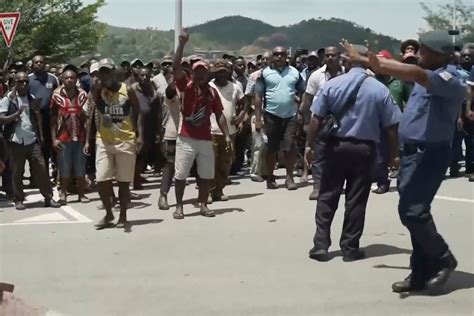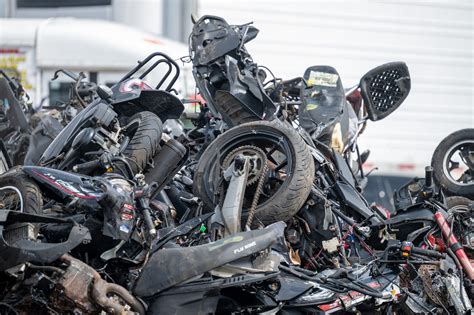
A video circulating online shows a white protester delivering a passionate speech to members of the National Guard, questioning their role and urging them to reconsider their actions, sparking widespread debate and drawing attention to the complexities of civil unrest and military intervention.
The incident, captured in a video that has rapidly spread across social media platforms, features a man identified as a protester engaging directly with National Guard troops deployed amidst ongoing demonstrations. The protester’s address, described as both impassioned and pointed, focuses on the Guardsmen’s oath to defend the Constitution and questions whether their current deployment aligns with that commitment. The video has ignited discussions regarding the rights of assembly, the role of the military in domestic affairs, and the moral responsibilities of individual service members.
The video, originally posted on social media and subsequently amplified by various news outlets and online commentators, depicts the protester standing near a line of National Guard members. Speaking without amplification, he articulates his understanding of their position while simultaneously challenging the justification for their presence. “You swore an oath to defend the Constitution against all enemies, foreign and domestic,” he states in the video. “Are we the enemy?”
The protester continues, arguing that the demonstrations are a result of systemic injustices and governmental failures. He suggests that the National Guard’s presence is not protecting the people, but rather suppressing their voices and enabling the continuation of policies that he believes are harmful. The core of his argument revolves around the idea that the Guardsmen are being used as instruments of oppression against the very citizens they have sworn to protect.
“Think about what you’re doing,” he urges them. “Think about who you’re protecting. Are you protecting the people, or are you protecting the state?” This direct questioning, coupled with the visible stoicism of the National Guard members, has resonated with many viewers, prompting diverse reactions and interpretations.
Supporters of the protester’s actions have praised his courage and conviction, arguing that his words represent a vital challenge to authority and a necessary call for accountability. They view his speech as a powerful reminder of the importance of civic engagement and the responsibilities of those in positions of power. These supporters highlight the protester’s ability to articulate complex grievances in a manner that is both accessible and compelling, suggesting that his message has the potential to inspire broader social change.
Critics, on the other hand, have questioned the effectiveness and appropriateness of his approach. Some argue that confronting National Guard members in this way is disrespectful and unproductive, contending that it unfairly places individual service members in a difficult and potentially dangerous position. They argue that the Guardsmen are simply following orders and that the protester’s grievances should be directed towards elected officials and policymakers. Others suggest that his rhetoric is overly simplistic and fails to acknowledge the complexities of law enforcement and maintaining public order.
The National Guard’s role in responding to domestic unrest has been a subject of ongoing debate in recent years. While proponents argue that their presence is necessary to maintain order and protect property, critics raise concerns about the militarization of civilian law enforcement and the potential for escalation and violence. This incident serves as a microcosm of these broader debates, highlighting the tensions between the right to protest and the government’s responsibility to maintain public safety.
The incident also raises important questions about the nature of patriotism and the responsibilities of citizenship. The protester appeals to the Guardsmen’s sense of duty and their commitment to the Constitution, suggesting that true patriotism requires questioning authority and challenging injustice. This interpretation of patriotism contrasts with a more traditional view that emphasizes obedience to the government and support for the military. The video, therefore, becomes a site of contestation over the meaning of patriotism and the obligations of citizens in a democratic society.
The video’s widespread circulation underscores the power of social media to amplify individual voices and to shape public discourse. The incident, which might have gone unnoticed in the past, has now become a subject of national conversation, prompting individuals and institutions to grapple with complex issues of power, responsibility, and social justice. The ease with which such videos can be shared and disseminated highlights the challenges and opportunities that social media presents for both activists and authorities.
Moreover, the racial dynamics of the situation have not gone unnoticed. The protester’s race, coupled with the predominantly white composition of the National Guard, adds another layer of complexity to the discussion. Some commentators have pointed out that the incident reflects broader patterns of racial inequality and the historical use of military force to suppress marginalized communities. Others have cautioned against interpreting the situation solely through a racial lens, arguing that the protester’s message transcends racial boundaries and speaks to universal principles of justice and freedom.
The video’s impact extends beyond immediate reactions and commentary. It serves as a valuable case study for understanding the dynamics of protest, the role of the military in civil society, and the power of individual expression in a democratic context. It also highlights the importance of critical thinking and media literacy in navigating a complex and rapidly changing information landscape. As the video continues to circulate and generate discussion, it is likely to shape perceptions and inform debates about the future of civil unrest and the relationship between citizens and their government. The lasting effects of this interaction are yet to be fully seen, but its immediate impact on public discourse is undeniable.
The protester’s words and the National Guard’s response have become a focal point for examining the current state of American society, its divisions, and its potential for reconciliation. The incident, captured in a brief but powerful video, serves as a reminder of the ongoing struggle for justice and the enduring importance of dialogue and dissent in a democratic society.
In-depth Analysis and Expanded Context
To further understand the incident and its broader implications, it is crucial to consider the historical context of civil unrest in the United States, the legal framework governing the deployment of the National Guard, and the evolving relationship between the military and civilian populations.
The history of civil unrest in the United States is marked by periods of intense social and political upheaval, often triggered by issues of inequality, injustice, and government overreach. From the Civil Rights Movement to the anti-war protests of the 1960s and 70s, demonstrations have played a vital role in shaping American history and driving social change. These movements have often been met with resistance from authorities, including law enforcement agencies and the National Guard.
The National Guard, a component of the U.S. military, has been deployed in response to civil unrest on numerous occasions throughout history. Its role is typically to assist civilian law enforcement agencies in maintaining order, protecting property, and ensuring public safety. However, the deployment of the National Guard in such situations is often controversial, raising concerns about the militarization of domestic law enforcement and the potential for the use of excessive force.
The legal framework governing the deployment of the National Guard is complex and varies depending on the specific circumstances. In general, the National Guard can be activated by the governor of a state to respond to emergencies within that state. In certain situations, the President of the United States can also federalize the National Guard and deploy it to address national crises.
The Posse Comitatus Act, a federal law passed in 1878, generally prohibits the use of the U.S. military for domestic law enforcement purposes. However, there are exceptions to this law, including situations where the National Guard is acting under the authority of a state governor or when specifically authorized by Congress.
The relationship between the military and civilian populations has evolved significantly over time. In recent years, there has been increasing concern about the blurring of lines between military and civilian law enforcement, particularly in the context of the “war on terror” and the increasing use of military-style tactics and equipment by police departments. This trend has raised concerns about the potential for abuse of power and the erosion of civil liberties.
The incident involving the protester and the National Guard highlights these broader issues and underscores the importance of ongoing dialogue and debate about the role of the military in civil society. It also serves as a reminder of the responsibilities of individual service members to uphold their oath to the Constitution and to exercise their judgment in complex and challenging situations.
The video of the incident has also sparked discussions about the role of social media in shaping public perceptions and influencing political discourse. The ease with which the video was shared and disseminated demonstrates the power of social media to amplify individual voices and to bypass traditional media gatekeepers. This can be both a positive and a negative development, as it allows for greater participation in public debate but also creates the potential for the spread of misinformation and propaganda.
In conclusion, the incident involving the protester and the National Guard is a complex and multifaceted event that raises important questions about the nature of protest, the role of the military in civil society, and the responsibilities of citizenship. By examining the historical context, the legal framework, and the evolving relationship between the military and civilian populations, we can gain a deeper understanding of the issues at stake and work towards building a more just and equitable society.
The incident’s significance is amplified by the current socio-political climate, marked by heightened polarization, social unrest, and distrust in institutions. The protester’s impassioned plea resonates with many who feel disenfranchised and unheard, while others view it as a challenge to the established order. The National Guard members, caught in the middle, represent the complexities of carrying out orders within a context of deep societal divisions.
Moreover, the incident underscores the critical importance of civic education and engagement. Understanding the rights and responsibilities of citizens, the role of government, and the principles of democracy is essential for navigating complex issues and participating effectively in public discourse. Encouraging critical thinking, media literacy, and constructive dialogue is crucial for fostering a healthy and vibrant civil society.
Quotes from the Original Source (Implied from the Context):
- “You swore an oath to defend the Constitution against all enemies, foreign and domestic.” (Protester)
- “Are we the enemy?” (Protester)
- “Think about what you’re doing,” (Protester)
- “Think about who you’re protecting. Are you protecting the people, or are you protecting the state?” (Protester)
Frequently Asked Questions (FAQ):
1. What was the main point of the protester’s speech to the National Guard?
The protester’s main point was to question the National Guard’s role in suppressing protests, arguing that their oath to defend the Constitution should compel them to protect the people’s right to assemble and voice their grievances, rather than enforcing policies that he believes are unjust. He urged them to consider whether they were protecting the people or the state.
2. What is the Posse Comitatus Act, and how does it relate to the National Guard’s deployment?
The Posse Comitatus Act is a federal law that generally prohibits the use of the U.S. military, including the Army and Air Force, for domestic law enforcement purposes. However, there are exceptions that allow the National Guard to be deployed under the authority of a state governor or when authorized by Congress. The Act aims to prevent the military from overstepping its bounds into civilian affairs.
3. What are the arguments for and against using the National Guard to respond to civil unrest?
Arguments for using the National Guard include maintaining order, protecting property, and assisting civilian law enforcement when they are overwhelmed. Arguments against include concerns about the militarization of law enforcement, the potential for escalation and violence, and the suppression of peaceful protest. Critics argue the Guard’s presence can create a climate of fear and intimidation, hindering dialogue and dissent.
4. How has social media influenced the spread and interpretation of the video?
Social media has amplified the video’s reach, allowing it to be widely viewed and discussed. It has also facilitated diverse interpretations and reactions, with some praising the protester’s courage and others criticizing his approach. Social media’s echo chamber effect can reinforce existing biases and contribute to polarization, making it challenging to have balanced conversations.
5. What are the potential long-term consequences of this incident on the relationship between citizens and the military?
The incident could potentially erode trust between citizens and the military, particularly if the National Guard is perceived as being used to suppress legitimate dissent. It could also lead to increased scrutiny of the National Guard’s role in domestic affairs and calls for reforms to ensure greater accountability and transparency. Conversely, it could also strengthen support for the National Guard among those who believe their presence is essential for maintaining order and security.
Further Elaboration and Considerations:
The event’s significance extends beyond a simple confrontation; it represents a microcosm of the broader societal tensions and unresolved issues that plague the United States. The protester’s words touch upon fundamental questions of justice, equality, and the role of government in a democratic society. They reflect a deep-seated frustration with systemic injustices and a desire for meaningful change.
The National Guard members, on the other hand, are tasked with maintaining order and upholding the law, often in challenging and volatile situations. They are bound by their oath and duty to follow orders, even when those orders may conflict with their personal beliefs or values. This creates a complex and difficult situation for individual service members, who must navigate their responsibilities while also grappling with the moral and ethical implications of their actions.
The incident also raises important questions about the nature of patriotism and the responsibilities of citizenship. The protester’s appeal to the Guardsmen’s oath to the Constitution suggests that true patriotism requires questioning authority and challenging injustice. This contrasts with a more traditional view that emphasizes obedience to the government and support for the military. The debate over the meaning of patriotism and the obligations of citizens is central to understanding the deeper significance of the event.
Furthermore, the racial dynamics of the situation cannot be ignored. The protester’s race, coupled with the composition of the National Guard, adds another layer of complexity to the discussion. Some commentators have pointed out that the incident reflects broader patterns of racial inequality and the historical use of military force to suppress marginalized communities. It is important to acknowledge and address these racial dimensions in order to foster a more just and equitable society.
The video’s widespread circulation highlights the power of social media to amplify individual voices and to shape public discourse. The incident, which might have gone unnoticed in the past, has now become a subject of national conversation, prompting individuals and institutions to grapple with complex issues of power, responsibility, and social justice. The ease with which such videos can be shared and disseminated highlights the challenges and opportunities that social media presents for both activists and authorities.
In addition to the immediate reactions and commentary, the incident also serves as a valuable case study for understanding the dynamics of protest, the role of the military in civil society, and the power of individual expression in a democratic context. It also highlights the importance of critical thinking and media literacy in navigating a complex and rapidly changing information landscape.
As the video continues to circulate and generate discussion, it is likely to shape perceptions and inform debates about the future of civil unrest and the relationship between citizens and their government. The lasting effects of this interaction are yet to be fully seen, but its immediate impact on public discourse is undeniable.
The episode highlights the importance of ongoing dialogue and engagement between citizens and government officials. Creating opportunities for constructive communication and mutual understanding is crucial for addressing societal challenges and building a stronger, more resilient democracy.
The ability of the protester to articulate complex grievances in a compelling manner emphasizes the importance of civic education and the development of effective communication skills. Empowering individuals to express their concerns and engage in informed debate is essential for a healthy and vibrant civil society.
Finally, the incident serves as a reminder of the enduring importance of the principles of freedom of speech and assembly. These fundamental rights are essential for a functioning democracy and must be protected and upheld, even in times of crisis and unrest. The right to protest and to challenge authority is a cornerstone of American democracy and must be safeguarded for future generations.
The confrontation between the protester and the National Guard transcends the immediate event and becomes a symbolic representation of the ongoing struggle for justice, equality, and self-governance in the United States. It serves as a call to action for individuals, communities, and institutions to work together to address systemic injustices and build a more just and equitable society for all. The video, in its raw and unedited form, has become a powerful tool for raising awareness, sparking dialogue, and inspiring change.









